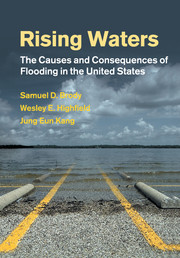Book contents
- Frontmatter
- Contents
- Preface
- Acknowledgments
- Abbreviations
- 1 Introduction: rising waters
- Part I The consequences of floods
- Part II Planning decisions and flood attenuation
- 5 Identifying the factors influencing flooding and flood damage
- 6 The role of wetlands: federal policies, losses, and floods
- 7 Mitigation strategies and reduction of flood damages
- 8 Other factors influencing flooding and flood damage
- Part III What are we learning?
- Part IV Policy implications and recommendations
- 12 Conclusions
- References
- Index
7 - Mitigation strategies and reduction of flood damages
from Part II - Planning decisions and flood attenuation
Published online by Cambridge University Press: 28 April 2011
- Frontmatter
- Contents
- Preface
- Acknowledgments
- Abbreviations
- 1 Introduction: rising waters
- Part I The consequences of floods
- Part II Planning decisions and flood attenuation
- 5 Identifying the factors influencing flooding and flood damage
- 6 The role of wetlands: federal policies, losses, and floods
- 7 Mitigation strategies and reduction of flood damages
- 8 Other factors influencing flooding and flood damage
- Part III What are we learning?
- Part IV Policy implications and recommendations
- 12 Conclusions
- References
- Index
Summary
Nonstructural forms of mitigation, as described in Chapter 5, may be the most overlooked, yet promising approach to reducing the adverse effects of chronic flooding at the local level. Mitigation techniques via land use planning, education, training, etc. have been advocated by researchers for decades, yet remain virtually untested in the planning and management literature. This chapter addresses the issue by examining the impact of various nonstructural mitigation strategies on the severity of losses caused by floods in Texas and Florida. First, we investigate the effectiveness of FEMA's CRS in reducing property damage and human casualties within the study's states. Second, we analyze specific mitigation techniques in more depth using a survey of floodplain administrators and local planners. Results show the extent to which nonstructural measures are adopted throughout the study area and the degree to which they reduce adverse impacts from floods. These findings provide guidance to local decision makers in coastal regions on how to establish programs that foster flood-resilient communities.
FEMA's CRS as a vehicle for local flood mitigation
As detailed in Chapter 4, FEMA's CRS is meant to encourage local jurisdictions to exceed the NFIP's minimum standards for floodplain management. Participating communities implement flood mitigation measures in exchange for national flood insurance premium discounts of up to 45%. Credit points are assigned for 18 different flood mitigation activities falling within four designated series (see Table 4.1 in Chapter 4). Credit points are aggregated into classes, from lowest (9) to highest (1).
- Type
- Chapter
- Information
- Rising WatersThe Causes and Consequences of Flooding in the United States, pp. 103 - 129Publisher: Cambridge University PressPrint publication year: 2011



